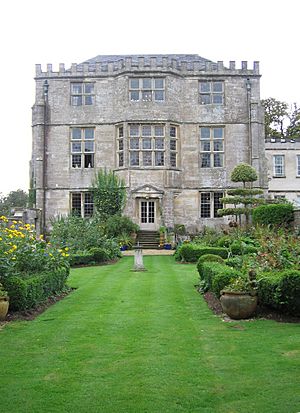Newark Park facts for kids
Quick facts for kids Newark Park |
|
|---|---|

The symmetrical front of the original lodge
|
|
| Type | Hunting Lodge |
| Location | Ozleworth |
| OS grid reference | ST 78107 93111 |
| Area | Gloucestershire |
| Owner | National Trust |
|
Listed Building – Grade I
|
|
| Official name: Newark Park, Ozleworth | |
| Designated | 6 Sep 1954 |
| Reference no. | 1227685 |
| Lua error in Module:Location_map at line 420: attempt to index field 'wikibase' (a nil value). | |
Newark Park is a beautiful old country house in Gloucestershire, England. It was built in the Tudor period and is considered a very important historical building. The house is located near the village of Ozleworth, close to Wotton-under-Edge. It sits on a large estate of about 700 acres (2.8 square kilometers). From the house, you can see amazing views of the Severn Valley and the Severn Estuary. Since 1946, Newark Park and its land have been looked after by the National Trust.
Contents
The Story of Newark Park
Newark Park started as a hunting lodge built between 1544 and 1556. It was made for a man named Sir Nicholas Poyntz. He was an important person who worked for King Henry VIII. His main home was Acton Court, which he had recently updated for a possible visit from the King.
Original Design and Building
The hunting lodge was first called "New Work." It had four floors, including a basement. It was built with materials from the nearby Kingswood Abbey, which had recently closed down. The lodge was designed to be very modern for its time, with a perfectly balanced front. It even had a special type of Tuscan order door.
The original building was quite simple, with one room on each floor.
- The basement held the kitchen.
- The ground floor had two living rooms.
- The first floor had a large room for banquets (big dinners).
- The top floor had small bedrooms.
The roof was flat, so people could go up and enjoy the amazing views of the countryside. This original part of the lodge is now the eastern side of the house you see today.
How the House Grew Over Time
In 1600, the Low family bought Newark Park. In 1672, they made the house much bigger. They added a second four-story building to the west. A passage and a stairway connected the new part to the old, making the house look like the letter "H" from above.
The Harding family bought the house in 1722. They made some small changes. Then, in 1790, James Clutterbuck bought it. He hired a famous architect named James Wyatt to redesign the house. They also created a special deer park and improved the gardens around the house.
Later Owners and Changes
The Clutterbuck family left Newark Park in 1860. After that, different people rented the house. Even though they were tenants, they continued to make improvements. In 1898, Mrs. Annie Poole King rented the house. She was a widow with five children and several staff members, including a cook and a gardener.
The King family added rooms for servants on the north side. They also put in a hot-air heating system and made sure hot water reached the second floor. The Kings stayed at Newark Park until 1949. After the last King family member died, the owner at the time, Mrs. Power-Clutterbuck, gave Newark Park and its lands to the National Trust.
Saving Newark Park
When the National Trust first took over, they didn't open Newark Park to the public. Instead, they rented it out as a nursing home. By 1970, the house was in bad shape, and the gardens were overgrown.
Robert Parsons' Restoration Work
An American architect named Robert (Bob) Parsons decided to rent the house. He had always wanted to restore an old English country house. Bob Parsons started a careful project to fix, preserve, and bring the house and gardens back to life. Because of his hard work, the house's important architecture was recognized. It was then given a special "Grade I" listing, meaning it's a building of exceptional interest.
Bob Parsons' partner, Michael Claydon, moved to Newark Park in 1982. He also helped a lot with the ongoing restoration. After Bob Parsons passed away in 2000, Michael Claydon continued to look after the house and work on the beautiful parkland.
Visiting Newark Park
Today, Newark Park is open to the public during the summer months. Visitors can explore the house and its lovely grounds.

